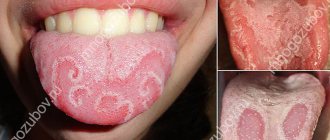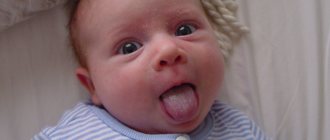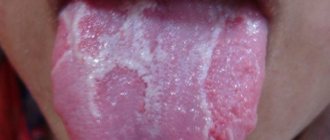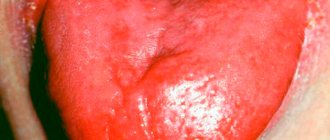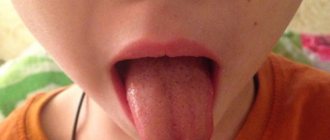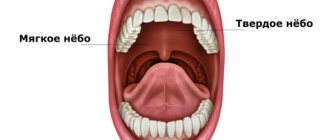Treatment of tongue abnormalities
Treatment methods for anomalies depend on the degree of their severity and dysfunction. In some cases, specialists choose observational tactics and only after a while decide on the need for surgical intervention. There is no treatment for a folded tongue; it is recommended to maintain oral hygiene. There is no therapy for lingual tonsils or microglossia.
Anomalies of attachment, enlargement, and splitting of the tongue are eliminated surgically. If ankyloglossia interferes with sucking, excision of the frenulum of the tongue is performed in the maternity hospital. If sucking is not impaired, then the operation is performed at an older age. During intervention, the adherent frenulum is cut using scissors, a scalpel or a laser. There is virtually no bleeding and no stitches are required.
Surgical treatment of an enlarged tongue is carried out in case of dysfunction of its functions, permanent injury, or changes in bite. Surgery to eliminate macroglossia depends on the degree of dysfunction. Cleft tongue is operated on at an early age. During plastic surgery, tissues are stitched together and a complete organ is formed. The struma of the root of the tongue is carried out conservatively, but in case of complications (bleeding, impaired swallowing and breathing), partial or radical removal of the ectopic glandular tissue is performed.
Prognosis and prevention
The complete absence of tongue in combination with other multiple developmental defects has an unfavorable prognosis and can be fatal. Macroglossia, ankyloglossia, and cleft tongue can be surgically corrected. A folded tongue, lingual tonsils, and lingual goiter do not pose a threat to life, but should be observed by specialists (dentist, endocrinologist, otolaryngologist). There is no specific prevention of developmental anomalies. General preventive measures include giving up bad habits, treating chronic diseases, taking multivitamins for pregnant women, proper nutrition and lifestyle. Source: https://www.krasotaimedicina.ru/diseases/zabolevanija_stomatology/tongue-anomaly
What it is
Officially, painful cracks on the tongue and along the edge of the tongue are called glossalgia. This is a fairly common neurosomatic disease.
Most common symptoms:
- dryness in the tongue area;
- itching and burning;
- swelling;
- soreness.
The insidiousness of glossalgia is that it does not go away on its own; without appropriate treatment it is impossible to get rid of a crack in the tongue.
At an early stage of the disease, the doctor may not notice pronounced cracks in the tongue, since they are microscopic and mainly manifest themselves as burning and pain. If you do not respond to this symptom in a timely manner, over time a crack may form at the tip or in the middle of the tongue, longitudinally, as well as cracks under the tongue and on the sides. In this case, the doctor also notes swelling and swelling of the tongue, atrophy of the salivary glands and filiform papillae on the surface of the tongue. The sooner you start treatment, the easier it is to get rid of glossalgia, so if you have cracks in your tongue, you should immediately consult a doctor.
Reasons for appearance
Reasons for education:
- lack of nutrients, iron and vitamin PP in the patient’s body;
- anemia;
- lack of B vitamins;
- allergic reaction to toothpaste or medications;
- chronic fatigue and constant nervous tension;
- mechanical damage to the tongue (nervous biting, chewing);
- disruption of capillary blood flow in the tongue;
- the patient has diseases such as gastritis, enterocolitis, hepatitis, cholecystitis;
- wearing uncomfortable dentures.
The main reason why the tongue is cracked is mechanical injuries due to a lack of vitamins and microelements in the patient’s body. In this case, it is enough to bite your tongue while chewing food so that a painful crack forms at its tip.
Another fairly common reason why a patient’s tongue is cracked is a malfunction in the patient’s central nervous system, which is caused by chronic fatigue, frequent stress, and lack of sleep. This is a reason to suspect a problem with the hypothalamus.
It happens that patients are perplexed: why there are cracks on the tongue, there seems to be no visible reason for their appearance. In this case, the answer to the question of why cracks appear can only be given by an experienced doctor, after a thorough diagnosis. It is necessary to do a detailed blood test to determine which microelements and vitamins are missing in the patient’s body. Quite often, correction of the nutritional system helps get rid of the disease.
Many people are probably interested in the question of what cracks mean. After all, the tongue, as is known, signals the presence of many diseases and pathological conditions of the human body. Cracks in the tongue are a sign of a lack of vitamins and microelements in the body. Quite often, cracks are caused by worms, as they deplete the human body, causing anemia and iron deficiency. They also indicate a diseased liver, since with this disease the human body does not receive many microelements important for health.
Cracks in the tongue on the side can be a sign of thyroid disease; in this case, it swells and is injured at the edges by the patient’s teeth.
Pathogenesis
The universal mechanisms of language developmental defects have not been determined. It is believed that the anomalies occur when the development of the first and second gill arches and the growth of the ligular primordia are disrupted. There is an opinion that at the end of the second month of intrauterine development of the fetus, the blood supply to the branchial arch changes. Until the 2nd month, blood comes from the internal carotid artery, and after that - from the external carotid artery. The period of changes in blood supply can be a trigger point in the formation of defects of the maxillofacial area in the presence of endogenous and exogenous aggravating factors.
Diagnostics
Diagnosis of linguistic anomalies does not present any difficulties. The presence of serious malformations is determined by a neonatologist in the maternity hospital; less pronounced anomalies are diagnosed by a dentist or surgeon during a routine examination. Additional research methods are rarely used. Differential diagnosis of defects is carried out with glossitis, neoplasms, and inflammatory processes. The main diagnostic methods are:
- Visual inspection
. Intraoral examination is carried out using two mirrors. The size, shape, color, structure, anatomical and topographic location of the organ are assessed. Examine the mucous membrane of the tongue, the severity of the papillae, the presence of primary and secondary lesions. The degree of organ dysfunction is assessed.
- Teleradiogram
(TRG). A study in a lateral projection allows us to judge the size, area of the tongue, its relationship with the teeth and jaws. Studying the TRG parameters makes it possible to determine the presence of tongue anomalies and occlusion. For complex combined defects, a CT scan of the jaws and facial bones is performed.
Differentiation is required by congenital and acquired folded tongue: in the latter case, it may be a manifestation of Melkerson-Rosenthal syndrome. With this syndrome, other symptoms are also present - facial paralysis, swelling of the lips or face. In some clinical cases, the anomaly resembles sclerosing glossitis in the tertiary period of syphilis, which also needs to be differentiated.

